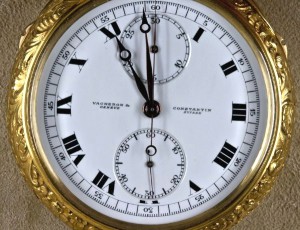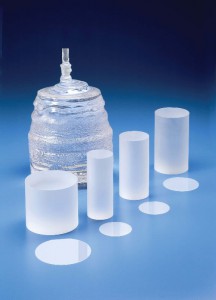Watches under the loupe: Watch glasses, materials and properties
Author: Michal Pindura Comments: 4 Created: 17.02.2021
Acrylic, non-scratchable, sapphire, anti-reflective, mineral. All of the listed and many other attributes belong to glass. To be more precise, watch glass. The irreplaceable part of every watch has undergone several developmental stages. Hand in hand with improving the watch design, they went miles though the procedures and materials used to make the transparent protection of dials and displays.
Crystal glass
The old master watchmakers put crystal glass in their first pocket and wristwatches. At that time, science and time had no knowledge of a more transparent, commonly available mass. Crystal's disadvantage was the high fragility and susceptibility to shock. The pocket watch solved this in the form of an opening metal cover for similar ailments. Their bracelet siblings were helped (during the wars) by a silver grid overlapping the dial.
Acrylic glass
As these various "covers" lacked practicality, it was useful to invent a synthetic material that was supposed to shade the glass in relevant aspects. Plastics have made their way to ever more widespread use and have not even bypassed the area of watches. The golden age of plastic glass was at its peak in the 1960s. Today, acrylic glass is mostly found in the lower-class watches or children's watches. Acrylate, i.e., plexiglass, more polymethyl methacrylate, the main benefits being low price, flexibility and attribute of forming blunt fragments minimising possible injuries. Scratches that you certainly can't avoid with acrylic, can be polished out relatively easily. Special pastes for polishing plastics (Displex, Xerapol, etc.) are used for this purpose. Modern, high-quality acrylic glasses can be found in some diving and military watches.
Mineral glass
No one can be bothered worrying everyday about the look of the watch glass. Engineers also considered this issue, taking general availability into account. Mineral glass has matured over time. It's a classic glass, which acquires the desired properties due to the action of heat and chemicals. In principle, the aim is increased scratch resistance. The physics and the fact that it is still a glass doesn't even deceive the sophisticated approach of scientists, even though they have managed to produce the most widespread type currently used in watches. Manufacturers sometimes coat mineral glass with their own - more ostentatious names. Seiko, for example, calls advanced mineral glass Hardlex (the seventh degree of hardness of the Mohs scale) and Sapphlex, which is a kind of cross between glass and sapphire.
Sapphire glass
If mineral glass holds the primacy in distribution, sapphire glass triumphs in desires. After all, who wouldn't want to brag about a piece of precious and extremely durable stone on their watch. However, sapphire is not like sapphire. On average, a three-centimetre gemstone, usually beautiful blue in colour, would be worn on the wrist by few without a flock of bodyguards around them. The watch sapphire glass originates in the laboratory and was formed by melting alumina (Al2O3) in the presence of hydrogen and oxygen at a temperature of 2000 °C. After crystallisation into a corundum "pear", it is cut and further processed to the desired shape and size.
With regard to sapphire glass, we often encounter an anti-reflective layer. Depending on the focus of the watch, it's anti-reflective on one or both sides of the glass. A chemical reaction stands behind the bluish coating, as well as behind the synthetic sapphire. The gas-transformed mixtures of alumina, magnesium fluoride and hafnium oxide transformed at 1800 °C by gradual deposition on the sapphire's surface form a coating which reduces undesired reflections. Sapphire glass does not seem to have a weakness. Nine hardness, scratches invisible. Appearance deceives, sapphire is a relatively fragile material, so expressive smacking on the ground results in shattering into thousands of small pieces. Anger and despair of ruin will not avoid you even in the event of a collision with corundum in sandpaper or your loved one's diamond ring.
Gorilla Glass
Launched a few years ago with the arrival of the iPhone, watches recently received a new impetus in the form of Gorilla Glass. This product from the American company Corning gained thirty times higher resistance than the original silica glass by replacing sodium ions with potassium in a four-stage bath. If you don't know what I'm talking about, the endurance demonstrations of Gorilla Glass on Youtube could be useful to you. Gorilla Glass has a wider lead in the watch so far.
I'm also curious what direction glasses will go in relation to watches and whether there will be any glasses at all in the future. One thing is for sure, customers are pushing manufacturers for relentless improvement and development in every single industry, not to mention watch glasses.
Add a comment
Comments (4)
| Kate M. | Laba diena Prašau ištaisyti klaidas! 1. "Minerálne sklíčko" Kas čia? Kokia kalba parašyta??? 2. Atsižvelgiant į laikrodžio paskirtį, antirefleksinis sluoksnis yra vienoje stikliuko pusėje, arba abiejuose pusėse. Abiejuose??? A BE JO se pusėse!!! 3. Tikras yra tik vienas dalykas, klientai verčia gamintojus nuolat tobulėti bei vykdyti plėtrą kiekvienoje šakoje, tame tarpe ir laikrodžių srityje. Tarp "dalykas" ir "klientai rašomas brūkšnelis!!! T.b. Tikras yra tik vienas dalykas - klientai verčia gamintojus nuolat tobulėti bei vykdyti plėtrą kiekvienoje šakoje, tame tarpe ir laikrodžių srityje. |
|---|---|
| Anna | Prosim o kratku informaciu, kolko by stala vymena rozbiteho sklicka na hodinkach TRIWA, chcela by som zafirove. Vopred dakujem za odpoved. |
| Mário | Chcem Vás poprosiť koĺko by stála výmena sklíčka sa hodinkách festina F20330 ďakujem za odpoveď. |
| Dimi | Traducerea dvs din ceha sau poloneza este neterminata. Prezentarea este interesantă.Așteptăm și alte detalii din lumea ceasurilor. |



